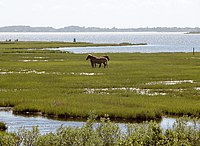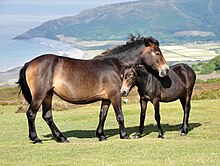Feral horse
This article needs additional citations for verification. (May 2015) |



A feral horse is a free-roaming horse of domesticated stock. As such, a feral horse is not a wild animal in the sense of an animal without domesticated ancestors. However, some populations of feral horses are managed as wildlife, and these horses often are popularly called "wild" horses. Feral horses are descended from domestic horses that strayed, escaped, or were deliberately released into the wild and remained to survive and reproduce there. Away from humans, over time, these animals' patterns of behavior revert to behavior more closely resembling that of wild horses. Some horses that live in a feral state but may be occasionally handled or managed by humans, particularly if privately owned, are referred to as "semi-feral".
Feral horses live in groups called a herd, band, harem, or mob. Feral horse herds, like those of
Feral horse populations
Americas
The best-known examples of modern day "wild" horses are those of the American West. When
Many prehistoric horse species, now
Asia
The only truly wild horses in existence today are Przewalski's horse native to the steppes of central Asia.
A modern wild horse population (janghali ghura) is found in the Dibru-Saikhowa National Park and Biosphere reserve of Assam, in north-east India, and is a herd of about 79 horses descended from animals that escaped army camps during World War II.[4]
Europe
In Portugal, a population of free-ranging horses, known as garrano, lives in the northern mountain chains.
In County Kerry, Ireland, wild bog ponies have been known since at least the 1300s.
More than 700 feral wild horses live in the foothills of Cincar Mountain, between Livno and Kupres, Bosnia and Herzegovina, in an area of roughly 145 km2 (56 sq mi). These animals, which descend from horses set free by their owners in the 1950s, enjoy a protected status since 2010.[5]
In Sardinia lives the Giara Horse, a wild species which inhabits the Giara di Gesturi, a basaltic plateau in the southern central part of the island. The popolation is composed by about 700 horses.[6]
Oceania
Australia has the largest population in the world, with about 400,000 horses.[7] The Australian name equivalent to the mustang is the brumby, descendants of horses brought to Australia by English settlers.[8][9]
Modern feral horses
Modern types of feral horses that have a significant percentage of their number living in a feral state, though domesticated representatives may exist, include these types, landraces, and breeds:
- Africa
- Kundudo horse, in the Kundudo region, Ethiopia; threatened with extinction
- Namib desert horse in Namibia
- North America
- see also Free-roaming horse management in North America
- Alberta Mountain Horse or Alberta Wildie, in the foothills of the Eastern Slopes of the Rocky Mountains of Alberta, Canada
- Banker horse on the Outer Banks of North Carolina, United States
- , United States
- Cumberland Island horse on Cumberland Island off the coast of southern Georgia, United States
- Nemaiah Valley, British Columbia, Canada[10]
- Mustang in the western United States, legally protected by the Wild and Free-Roaming Horses and Burros Act of 1971
- Nokota horse in North Dakota, United States
- Sable Island horse on Sable Island, Nova Scotia, Canada
- South America
- Lavradeiros in northern Brazil[11]
- Small wild horses are established in the páramos of the Sierra Nevada de Santa Marta in Spanish conquistadors.[12]
- A small population of feral horses lives in the foothills of Cordillera Real next to the city of La Paz in Bolivia; these individuals wander the high-altitude grassland up to 4700 m above sea level. The origin of this highly endangered herd is not well-known.
- Asia
- Misaki horse in Cape Toi, Japan
- Delft Island Horse on Neduntheevu or Delft Island, Sri Lanka. Feral Horses are believed to be the descendants of horses kept on the island from the time of Dutch occupation in Sri Lanka.[13]
- Yılkı horse in the Kızılırmak Delta and other places in Turkey[14]
- Europe
- Danube Delta Horse, in and around Letea Forest, Romania
- Garrano, a feral horse native to northern Portugal
- Giara horse in Sardinia
- Marismeño in the Doñana National Park in Huelva, Spain
- Konik, predominantly domesticated, but the biggest feral herd in the world lives in the Oostvaardersplassen reserve in the Netherlands.[15][16]
- Welsh Pony, mostly domesticated, but a feral population of about 180 animals [17] roams the Carneddau hills of North Wales. Other populations roam the eastern parts of the Brecon Beacons National Park
- Oceania
- Brumby in Australia
- Kaimanawa horse in New Zealand
- Marquesas Islands horse on Ua Huka, Marquesas Islands, French Polynesia[18]
Semi-feral horses

In the United Kingdom, herds of free-roaming ponies live in apparently wild conditions in various areas, notably Dartmoor, Exmoor, Cumbria (Fell Pony), and the New Forest. Similar horse and pony populations exist elsewhere on the European continent. These animals, however, are not truly feral, as all of them are privately owned, and roam out on the moors and forests under common grazing rights belonging to their owners. A proportion of them are halter-broken, and a smaller proportion broken to ride, but simply turned out for a while for any of a number of reasons (e.g., a break in training to allow them to grow on, a break from working to allow them to breed under natural conditions, or retirement). In other cases, the animals may be government-owned and closely managed on controlled reserves.
- Camargue horse, in marshes of the Rhone delta, southern France.
- Dartmoor pony, England; predominantly domesticated, also lives in semi-feral herds.
- Exmoor pony, England; predominantly domesticated, also lives in semi-feral herds.
- Fell pony, predominantly domesticated, also lives in semi-feral herds in northern England, particularly Cumbria.
- Gotlandsruss, lives in a semi-feral herd in Lojsta Moor on the Swedish Island of Gotland.
- New Forest pony, predominantly domesticated, also lives in semi-feral herds in the area of Hampshire, England.
- Pottok, predominantly domesticated, also lives in semi-feral herds in the western Pyrenees.
- Dülmen pony, a German pony that lives in a wild herd in Westphalia with little help by humans.
- Shetland pony, Scotland; predominantly used for riding, driving, and pack purposes.
Population impacts
Feral populations are usually controversial, with livestock producers often at odds with horse aficionados and other animal welfare advocates. Different habitats are impacted in different ways by feral horses. Where feral horses had wild ancestors indigenous to a region, a controlled population may have minimal environmental impact, particularly when their primary territory is one where they do not compete with domesticated livestock to any significant degree. However, in areas where they are an introduced species, such as Australia, or if the population is allowed to exceed available range, there can be significant impacts on soil, vegetation (including overgrazing), and animals that are native species.[8]
If a feral population lives close to civilization, their behavior can lead them to damage human-built livestock fencing and related structures.[9] In some cases, where feral horses compete with domestic livestock, particularly on public lands where multiple uses are permitted, such as in the Western United States, there is considerable controversy over which species is most responsible for degradation of rangeland, with commercial interests often advocating for the removal of the feral horse population to allow more grazing for cattle or sheep, and advocates for feral horses recommending reduction in the numbers of domestic livestock allowed to graze on public lands.
Certain populations have considerable historic or sentimental value, such as the
See also
- Horse behavior
- List of BLM Herd Management Areas
References
- ^ "American Wild Horse Preservation Campaign". wildhorsepreservation.com. Archived from the original on 21 November 2011. Retrieved 21 May 2015.
- ^ "Feral Horses: Get The Facts" (PDF). The Wildlife Society. Archived from the original (PDF) on 5 March 2012. Retrieved 4 April 2012.
- .
- ^ Dibru-Saikhowa National Park and Biosphere reserve Archived 11 June 2010 at the Wayback Machine
- ^ "Pušteni da slobodno žive u prirodi: Livanjski divlji konji — jednistvena atrakcija u Europi". Novi list (in Croatian). HINA. 2 August 2015. Retrieved 6 June 2017.
- ^ "Sezione del cavallo della Giara". Museo del Cavallino della Giara (in Italian). Retrieved 10 January 2024.
- ^ "Pest animal risk assessment — Feral Horse" (PDF). Queensland Primary Industries and Fisheries. June 2009. Archived from the original (PDF) on 16 March 2011. Retrieved 17 December 2010.
- ^ doi:10.1071/WR06102.
- ^ ISBN 0644252863.
- ^ SMS VSIP Consulting Inc. "Wild Horses". fonv.ca. Retrieved 21 May 2015.
- ^ Farid, Zain. "lavradeiros Feral Horse". Retrieved 19 December 2015.
- ISBN 9780851997483)
- ^ "Wild horse sanctuary for Sri Lanka's Delft Island". www.horsetalk.co.nz. Horse Talk. 26 December 2013. Archived from the original on 29 November 2016. Retrieved 29 November 2016.
- ^ "The Independent Spirit of Turkey: Wild Horse".
- ^ "Konik - Equus caballus var. konik | World". world.observation.org. Retrieved 10 March 2023.
- ^ "Grote grazers Oostvaardersplassen". Staatsbosbeheer (in Dutch). Retrieved 10 March 2023.
- ^ "Daily Post: Latest North Wales news, sport, what's on and business". northwales. Archived from the original on 9 March 2012. Retrieved 21 May 2015.
- ^ "Meet the last horsemen of these paradise islands". Travel. 20 December 2018. Archived from the original on 24 December 2018. Retrieved 24 December 2018.
- .
- ^ Bomford, M., & O'Brien, P. (1993). "Potential use of contraception for managing wildlife pests in Australia" Archived 20 August 2010 at the Wayback Machine. USDA National Wildlife Research Center Symposia. Retrieved on 12 May 2008.
